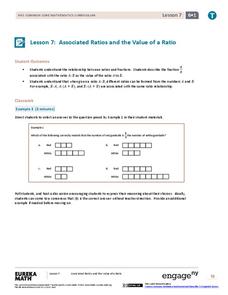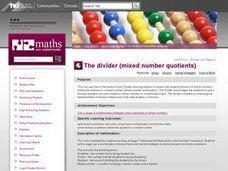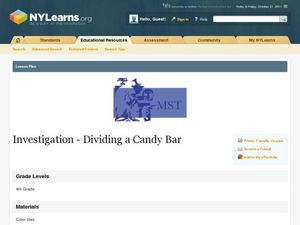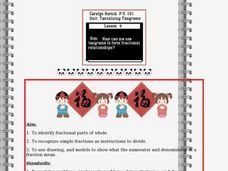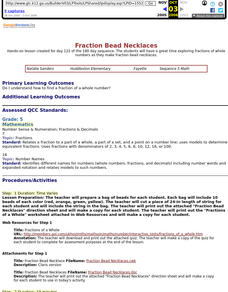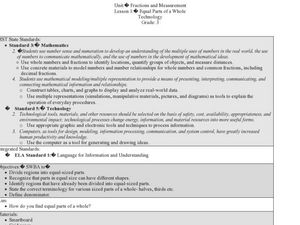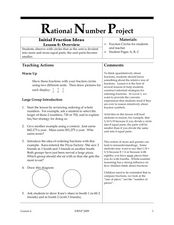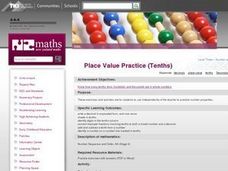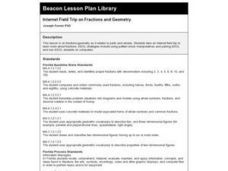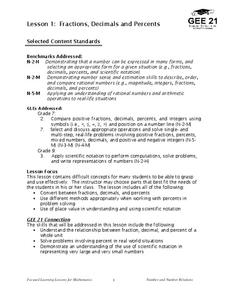EngageNY
Solving Percent Problems III
What happens when combining percentage discounts? The last lesson in a series of 29 introduces the idea of combining discounts one after another. Pupils wrestle with the claim that to find the total discount, they need to only add...
EngageNY
Associated Ratios and the Value of a Ratio
Do ratios have values? The seventh lesson in a series of 29 introduces the value of a ratio. Pupils create associated ratios to a given ratio. They also describe the fraction associated to the ratio as the value of the ratio.
Curated OER
Fractions: Mud Pie Math
Second graders identify and name fractional parts through the use of mud pie manipulatives. In this fractional manipulatives lesson, 2nd graders identify and label halves, thirds, fourths, sixths, eighths, and tenths and order them...
Curated OER
The divider (mixed number quotients)
his unit uses two of the series of four Divider learning objects to support the students division of whole numbers where the quotient is a mixed number (whole number and fraction). The Divider encourages the students to split a division...
Curated OER
Folded Fractions
Second graders, in pairs, use various geometric shapes to represent fractional parts and divide them into equal parts.
Curated OER
Dividing a Candy Bar
Fourth graders explore number values by utilizing a candy bar in class. In this fraction lesson plan, 4th graders divide pizza and candy amongst each other in order to identify parts of a whole and fractions. Students answer several...
Curated OER
Tantalizing Tangrams: Fractional Relationships
Students use tangrams to represent parts of a whole. In this fraction instructional activity, students use tangrams to determine fractional relationships between different pieces. Students use the AppleWorks drawing application to...
Curated OER
Popcorn Fractions
Upper graders explore fractions to determine a fractional part of a whole. They are given 30 pieces of popcorn and asked to divide it into halves, thirds, etc. Learners practice representing the popcorn groups as a numerator and...
Curated OER
Ordering Parts of a Whole
Students review and discuss the task to be completed and how the rubric is used to evaluate it. They each get 6 paper rectangles, 3 of one color and 3 of another color. They cut the rectangles in half two different ways. They repeat the...
Curated OER
Fractions - Equal or Not
A fabulous lesson on fractions awaits your young mathematicians. In it, learners are invited to explore the world of fractions by accessing websites that have educational activities and worksheets embedded in them. Some excellent,...
Science Matters
Thermal Energy Flow in Materials
The sun sends the earth 35,000 times the amount of energy required by all of us on the entire planet, every day. The fourth lesson in the 10-part series looks at how light energy from the sun transfers into thermal energy. Scholars build...
Curated OER
Fraction Bead Necklaces
Fifth graders explore fractions of whole numbers as they make fraction bead necklaces.
Curated OER
Changing the World: Social Entrepreneurs Part One
Students analyze the purpose of a social entrepreneur. In this entrepreneurship lesson, students create a "help wanted" advertisement and graphic organizer to provide information on how a social entrepreneur seeks long-term change by...
Curated OER
Fractions and Measurement
Using a Smart Board, or a plain ol' white board or chalkboard, the teacher pulls up a grid and demonstrates how squares and rectangles can be divided up into equal parts. The class will get their own graph paper to draw shapes and divide...
Curated OER
Piecing it Together: Adding & Subtracting Fractions
Students add and subtract fractions and mixed numbers with unlike denominators. They "fish" for and solve a number of fraction problems requiring adding, subtracting, finding equivalent fractions, and using mixed numbers.
Curated OER
Work with Congruent Parts
Students explore the concept of congruency. For this fractions lesson, students use paper plates to practice recognizing congruent parts as they make folds and cuts to represent equal parts.
Curated OER
Initial Fraction Ideas Lesson 6: Overview
Young scholars use fraction circles to observe fractions in smaller parts and to complete charting and word problem activities. In this fraction lesson plan, students complete chart problems, word problems, and fraction comparing...
Curated OER
Using Numbers in Everyday Situations
Students exercise the basic use of numbers in their everyday lives. In this numerical exercise, students discover the many ways numbers are used in everyday life. The students draw pictures showing examples of a time they have used...
Curated OER
Place Value Practice (Tenths)
Young scholars practice strategies solving problems with basic facts, framework, domain and early additive part-whole. They recall the compatible numbers to ten, solve problems with small numbers using a part-whole strategy and recall...
Curated OER
Fractions
Students determine that a fraction is a part of a whole or part of a group. They write and read fractions and solve various fraction problems. They create their own fraction problem using colored candies for their classmate to solve.
Curated OER
Equivalent Fractions
Introduce elementary students, grades 3-5 to the concept of equivalent fractions. Each student folds a paper in half and color one of the equal parts of the paper. They use this paper to define numerator, denominator and the idea that a...
Curated OER
Chocolate Math
Students utilize chocolate to identify parts of a whole. In this fractions lesson plan, students discover the vocabulary associated with fractions and practice dividing a chocolate bar into pieces based on fraction problems....
Curated OER
Internet Field Trip on Fractions and Geometry
Students take an Internet field trip to research fractions. ESOL strategies include using pattern block manipulatives and pairing ESOL and non-ESOL students on computers.
Curated OER
Fractions, Decimals and Percents
Students investigate the differences when using decimals, fractions, and percents. They focus on the process of using them in real problems and how to convert them from one form to another.

